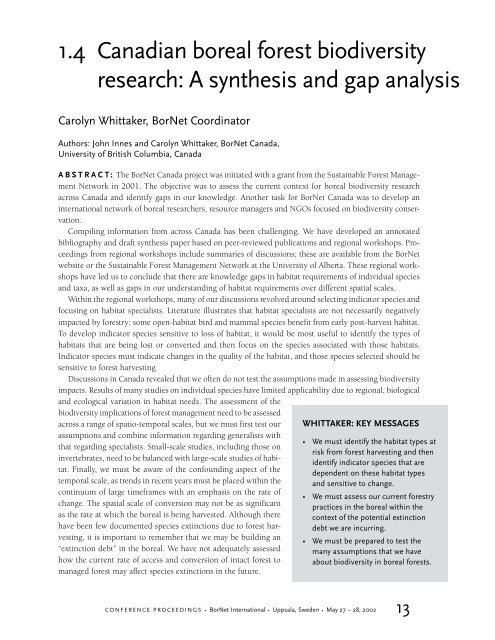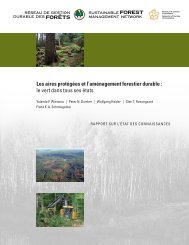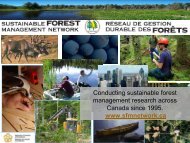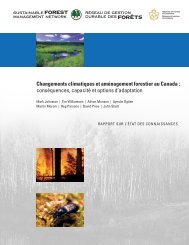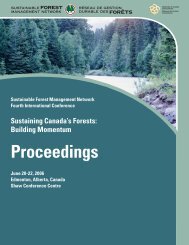Conference Proceedings - Sustainable Forest Management Network ...
Conference Proceedings - Sustainable Forest Management Network ...
Conference Proceedings - Sustainable Forest Management Network ...
Create successful ePaper yourself
Turn your PDF publications into a flip-book with our unique Google optimized e-Paper software.
1.4 Canadian boreal forest biodiversity<br />
research: A synthesis and gap analysis<br />
Carolyn Whittaker, BorNet Coordinator<br />
Authors: John Innes and Carolyn Whittaker, BorNet Canada,<br />
University of British Columbia, Canada<br />
ABSTRACT: The BorNet Canada project was initiated with a grant from the <strong>Sustainable</strong> <strong>Forest</strong> <strong>Management</strong><br />
<strong>Network</strong> in 2001. The objective was to assess the current context for boreal biodiversity research<br />
across Canada and identify gaps in our knowledge. Another task for BorNet Canada was to develop an<br />
international network of boreal researchers, resource managers and NGOs focused on biodiversity conservation.<br />
Compiling information from across Canada has been challenging. We have developed an annotated<br />
bibliography and draft synthesis paper based on peer-reviewed publications and regional workshops. <strong>Proceedings</strong><br />
from regional workshops include summaries of discussions; these are available from the BorNet<br />
website or the <strong>Sustainable</strong> <strong>Forest</strong> <strong>Management</strong> <strong>Network</strong> at the University of Alberta. These regional workshops<br />
have led us to conclude that there are knowledge gaps in habitat requirements of individual species<br />
and taxa, as well as gaps in our understanding of habitat requirements over different spatial scales.<br />
Within the regional workshops, many of our discussions revolved around selecting indicator species and<br />
focusing on habitat specialists. Literature illustrates that habitat specialists are not necessarily negatively<br />
impacted by forestry; some open-habitat bird and mammal species benefit from early post-harvest habitat.<br />
To develop indicator species sensitive to loss of habitat, it would be most useful to identify the types of<br />
habitats that are being lost or converted and then focus on the species associated with those habitats.<br />
Indicator species must indicate changes in the quality of the habitat, and those species selected should be<br />
sensitive to forest harvesting.<br />
Discussions in Canada revealed that we often do not test the assumptions made in assessing biodiversity<br />
impacts. Results of many studies on individual species have limited applicability due to regional, biological<br />
and ecological variation in habitat needs. The assessment of the<br />
biodiversity implications of forest management need to be assessed<br />
across a range of spatio-temporal scales, but we must first test our<br />
assumptions and combine information regarding generalists with<br />
that regarding specialists. Small-scale studies, including those on<br />
invertebrates, need to be balanced with large-scale studies of habitat.<br />
Finally, we must be aware of the confounding aspect of the<br />
temporal scale, as trends in recent years must be placed within the<br />
continuum of large timeframes with an emphasis on the rate of<br />
change. The spatial scale of conversion may not be as significant<br />
as the rate at which the boreal is being harvested. Although there<br />
have been few documented species extinctions due to forest harvesting,<br />
it is important to remember that we may be building an<br />
“extinction debt” in the boreal. We have not adequately assessed<br />
how the current rate of access and conversion of intact forest to<br />
managed forest may affect species extinctions in the future.<br />
WHITTAKER: KEY MESSAGES<br />
• We must identify the habitat types at<br />
risk from forest harvesting and then<br />
identify indicator species that are<br />
dependent on these habitat types<br />
and sensitive to change.<br />
• We must assess our current forestry<br />
practices in the boreal within the<br />
context of the potential extinction<br />
debt we are incurring.<br />
• We must be prepared to test the<br />
many assumptions that we have<br />
about biodiversity in boreal forests.<br />
CONFERENCE PROCEEDINGS • BorNet International • Uppsala, Sweden • May 27 – 28, 2002 13


